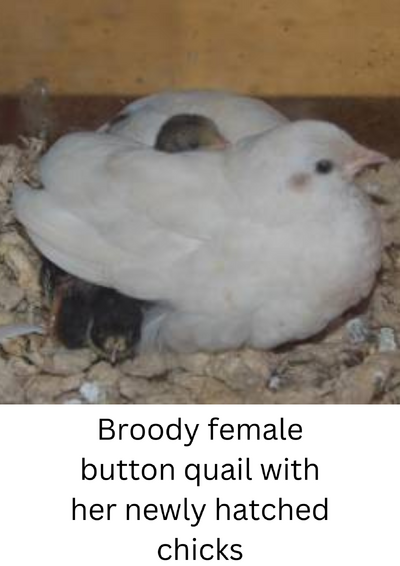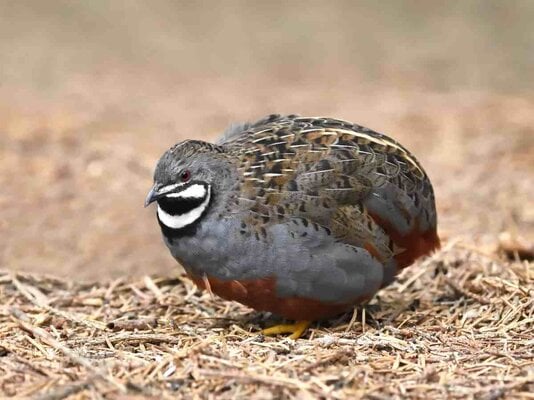Intro:
Button quail are small, extremely beautiful, and easy to care for birds when care for properly. They are fascinating little birds to watch and to keep as pets for their small size. Raising Button quail can be quite a rewarding and very fun experience, especially for those who are passionate about raising Button quail. These birds are native to Asia, Africa, Australia, and China, but now commonly bred in captivity, primarily for pet, exhibition, and food purposes. The true name of the most commonly kept type of Button quail is the actually called Chinese painted quail. They are so commonly kept that we have been able to breed different color variaties ranging in different beautiful colors. Chinese painted quail are the ones I'm referring to in the article.
Keeping Button Quail:
Button quail are one of the smallest types of all the quail breeds. They are very hardy and can adapt to various habitats and climates. Button quails prefer to live in a warm, dry and in draft-free environments, so a small cage or an aviary can be used to house them. However, it is important to consider the number of the Button quail to keep you are going to have an aviary. Because they do not like to be overcrowded. A cage should measure at least 34 by 24 inches and should be at least 18 inches in height. The cage should have tight wire mesh or screening that will not allow any predators to enter and should be cleaned frequently. Cleaning the cage often helps to keep the birds free of parasites and diseases.

Breeding Button Quail
Button quail tend to breed in the spring and summer and breeding is relatively easy when done with single pairs in their own cage or aviary. Adult males are easy to differentiate as their plumage is more colorful with brighter and more vivid colors, making for an interesting sight. Also, the adult females laying sizeable amounts of eggs that vary in color from white, beige, light and dark brown. To encourage breeding, it is essential to provide natural lighting with substrate and plants that mimic a natural environment and cycle birds. An adjustable light source with a timer is essential to simulate sunlight at an early dawn where the light stays on for at least 13 to 14 hours and off for the remaining night hours.

Breeding diet:
Additionally, quail feed that is rich in protein and key minerals must be added to their daily diet to aid in sufficient and healthy egg production. During breeding, a hen may lay three to four eggs per week, so they can easily lay up to one hundred eggs per year, making them great breeders. In order for hen to stay laying you need to take the eggs she lays. The eggs need an incubation temperature between 37.5-38°C and a humidity of 30.6-45.°C and should incubate for 13-14 days and should be put into lockdown at day 15
Raising Button Quail chicks:
Once the chicks hatch, the next step is to raise them properly. The chicks are born with a fluffy down covering on their bodies and are able to walk and feed themselves within hours of hatching. It is important to separate the chicks from other adult button quail to avoid aggression towards the newborns, at least for the first few weeks when they are still vulnerable. Unless if they hatched from a broody hen. They you need to move the pair to a setup where they can raise the chicks safely.

Brooder setup:
The chicks should be kept in a safe, soft, warm, and a well-lit brooder with a reliable heat source. A heat lamp that kerps them at around 40C and should be kep inside a brooder that is lined with clean litter, to reduce bacterial disease risk and increase comfortability. The brooder must be maintained clean and the litter changed frequently during the first few weeks, at least until the birds can regulate their body temperatures on their own.
Chick diet:
A well-balanced diet is essential during these early stages of the chicks development. Feeding them with a high protein diet, rich in calcium and vitamins is necessary to maintain good growth and overall health. Turkey starter mixed with crushed boiled eggs, crushed insects, and mealworms are key examples of a high protein diet for a young button quail.
Safe grow out setup:
As your button quails continue to grow and mature, they will need a more spacious, and safe pen to live in. An aviary, constructed with tight meshing and plenty of room, should be considered. The environment and space should be mimicking their natural habitat, with excellent space for them to grow and flourish. A large aviary that allows the birds to fly around plant, rocks, ground level logs, and indoor perches, indicated by wooden logs.

Conclusion:
In conclusion, button quail are easy to care for and maintain for anyone with the time, making them an ideal pet bird and perfect for beginner quail breeders and owners. It is crucial to maintain a clean, warm, and draft-free environment, give them a well-balanced diet, and to simulate a natural environment during breeding and incubation periods. A large aviary will help the birds to grow and flourish in an environment that mimics their natural habitat. Remember, to give them plenty of love and care, and they will reward you with their loving personality, beauty, and their amazing song,
Button quail are small, extremely beautiful, and easy to care for birds when care for properly. They are fascinating little birds to watch and to keep as pets for their small size. Raising Button quail can be quite a rewarding and very fun experience, especially for those who are passionate about raising Button quail. These birds are native to Asia, Africa, Australia, and China, but now commonly bred in captivity, primarily for pet, exhibition, and food purposes. The true name of the most commonly kept type of Button quail is the actually called Chinese painted quail. They are so commonly kept that we have been able to breed different color variaties ranging in different beautiful colors. Chinese painted quail are the ones I'm referring to in the article.
Keeping Button Quail:
Button quail are one of the smallest types of all the quail breeds. They are very hardy and can adapt to various habitats and climates. Button quails prefer to live in a warm, dry and in draft-free environments, so a small cage or an aviary can be used to house them. However, it is important to consider the number of the Button quail to keep you are going to have an aviary. Because they do not like to be overcrowded. A cage should measure at least 34 by 24 inches and should be at least 18 inches in height. The cage should have tight wire mesh or screening that will not allow any predators to enter and should be cleaned frequently. Cleaning the cage often helps to keep the birds free of parasites and diseases.
Breeding Button Quail
Button quail tend to breed in the spring and summer and breeding is relatively easy when done with single pairs in their own cage or aviary. Adult males are easy to differentiate as their plumage is more colorful with brighter and more vivid colors, making for an interesting sight. Also, the adult females laying sizeable amounts of eggs that vary in color from white, beige, light and dark brown. To encourage breeding, it is essential to provide natural lighting with substrate and plants that mimic a natural environment and cycle birds. An adjustable light source with a timer is essential to simulate sunlight at an early dawn where the light stays on for at least 13 to 14 hours and off for the remaining night hours.
Breeding diet:
Additionally, quail feed that is rich in protein and key minerals must be added to their daily diet to aid in sufficient and healthy egg production. During breeding, a hen may lay three to four eggs per week, so they can easily lay up to one hundred eggs per year, making them great breeders. In order for hen to stay laying you need to take the eggs she lays. The eggs need an incubation temperature between 37.5-38°C and a humidity of 30.6-45.°C and should incubate for 13-14 days and should be put into lockdown at day 15
Raising Button Quail chicks:
Once the chicks hatch, the next step is to raise them properly. The chicks are born with a fluffy down covering on their bodies and are able to walk and feed themselves within hours of hatching. It is important to separate the chicks from other adult button quail to avoid aggression towards the newborns, at least for the first few weeks when they are still vulnerable. Unless if they hatched from a broody hen. They you need to move the pair to a setup where they can raise the chicks safely.
Brooder setup:
The chicks should be kept in a safe, soft, warm, and a well-lit brooder with a reliable heat source. A heat lamp that kerps them at around 40C and should be kep inside a brooder that is lined with clean litter, to reduce bacterial disease risk and increase comfortability. The brooder must be maintained clean and the litter changed frequently during the first few weeks, at least until the birds can regulate their body temperatures on their own.
Chick diet:
A well-balanced diet is essential during these early stages of the chicks development. Feeding them with a high protein diet, rich in calcium and vitamins is necessary to maintain good growth and overall health. Turkey starter mixed with crushed boiled eggs, crushed insects, and mealworms are key examples of a high protein diet for a young button quail.
Safe grow out setup:
As your button quails continue to grow and mature, they will need a more spacious, and safe pen to live in. An aviary, constructed with tight meshing and plenty of room, should be considered. The environment and space should be mimicking their natural habitat, with excellent space for them to grow and flourish. A large aviary that allows the birds to fly around plant, rocks, ground level logs, and indoor perches, indicated by wooden logs.
Conclusion:
In conclusion, button quail are easy to care for and maintain for anyone with the time, making them an ideal pet bird and perfect for beginner quail breeders and owners. It is crucial to maintain a clean, warm, and draft-free environment, give them a well-balanced diet, and to simulate a natural environment during breeding and incubation periods. A large aviary will help the birds to grow and flourish in an environment that mimics their natural habitat. Remember, to give them plenty of love and care, and they will reward you with their loving personality, beauty, and their amazing song,



